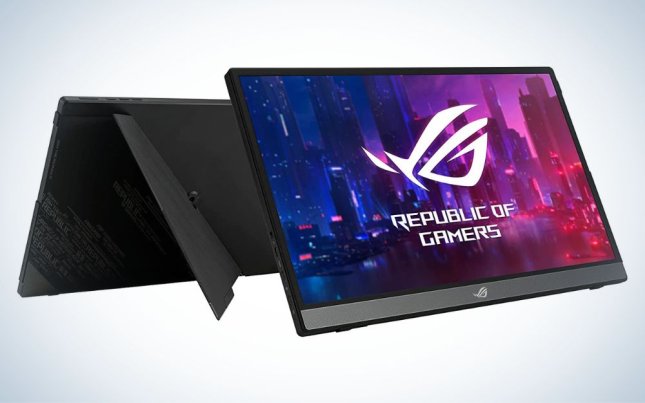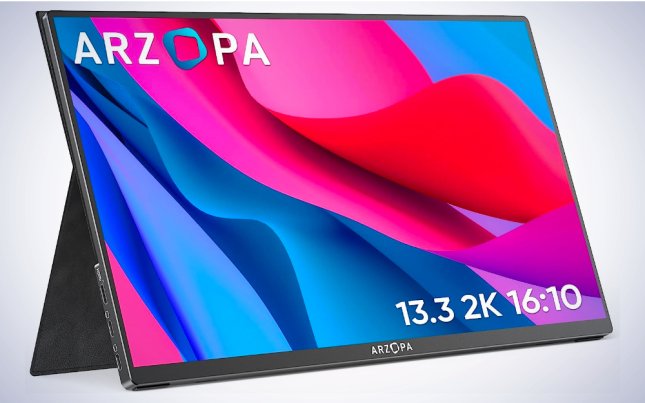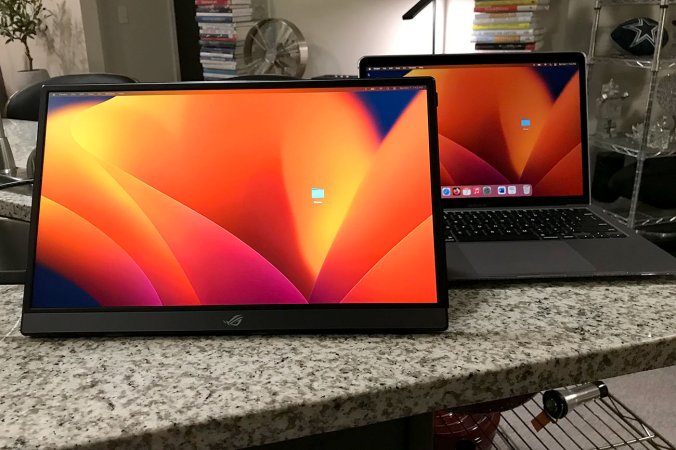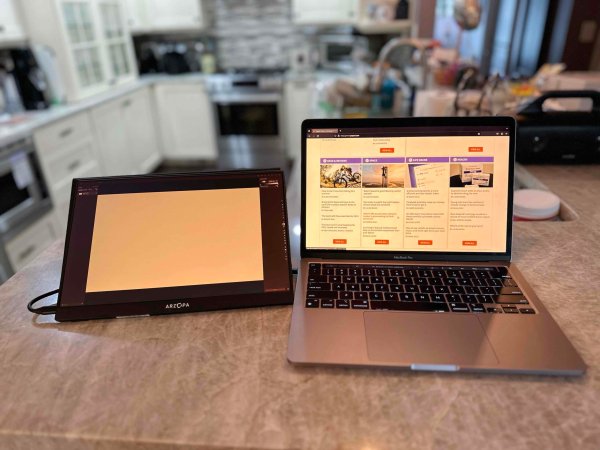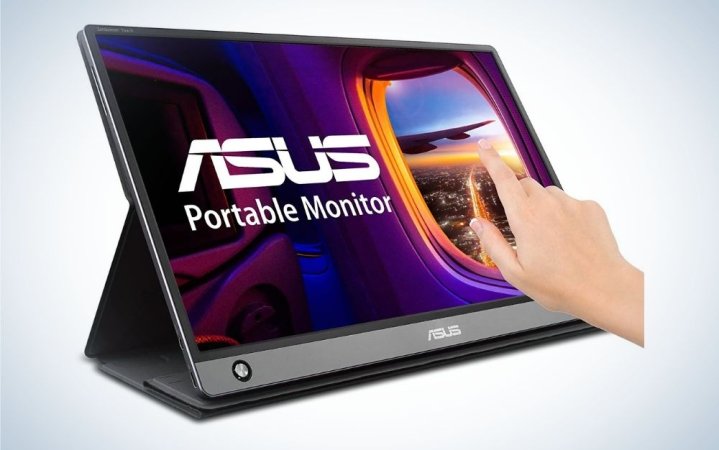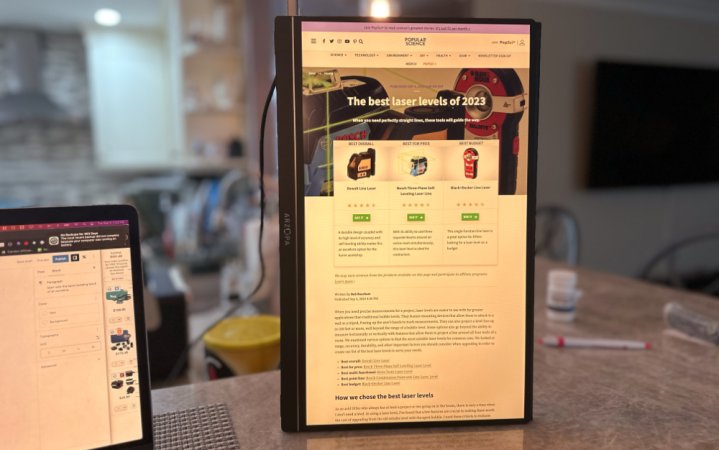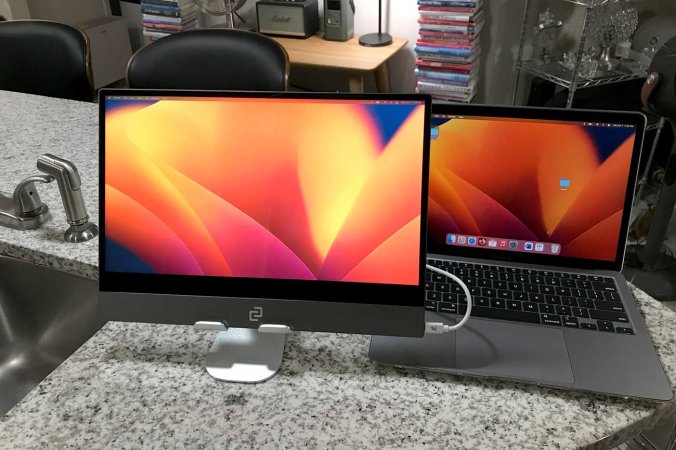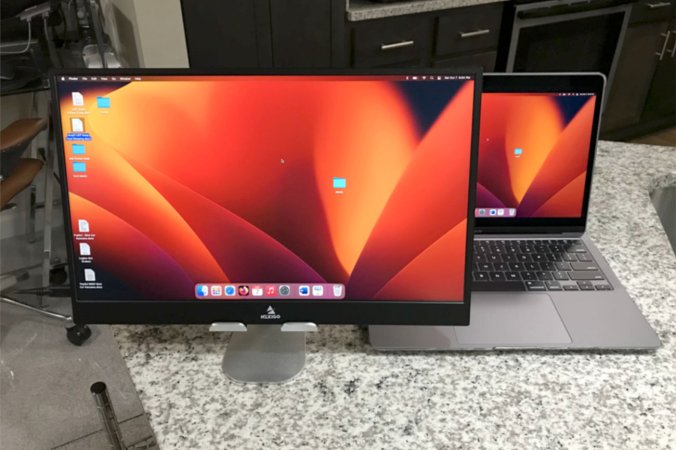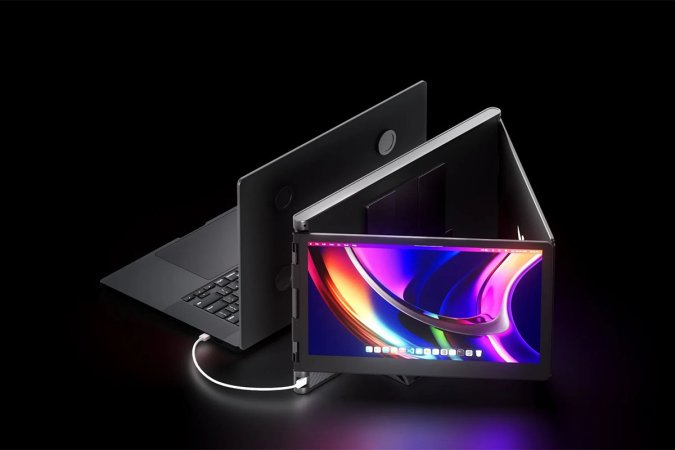We may earn revenue from the products available on this page and participate in affiliate programs. Learn more ›
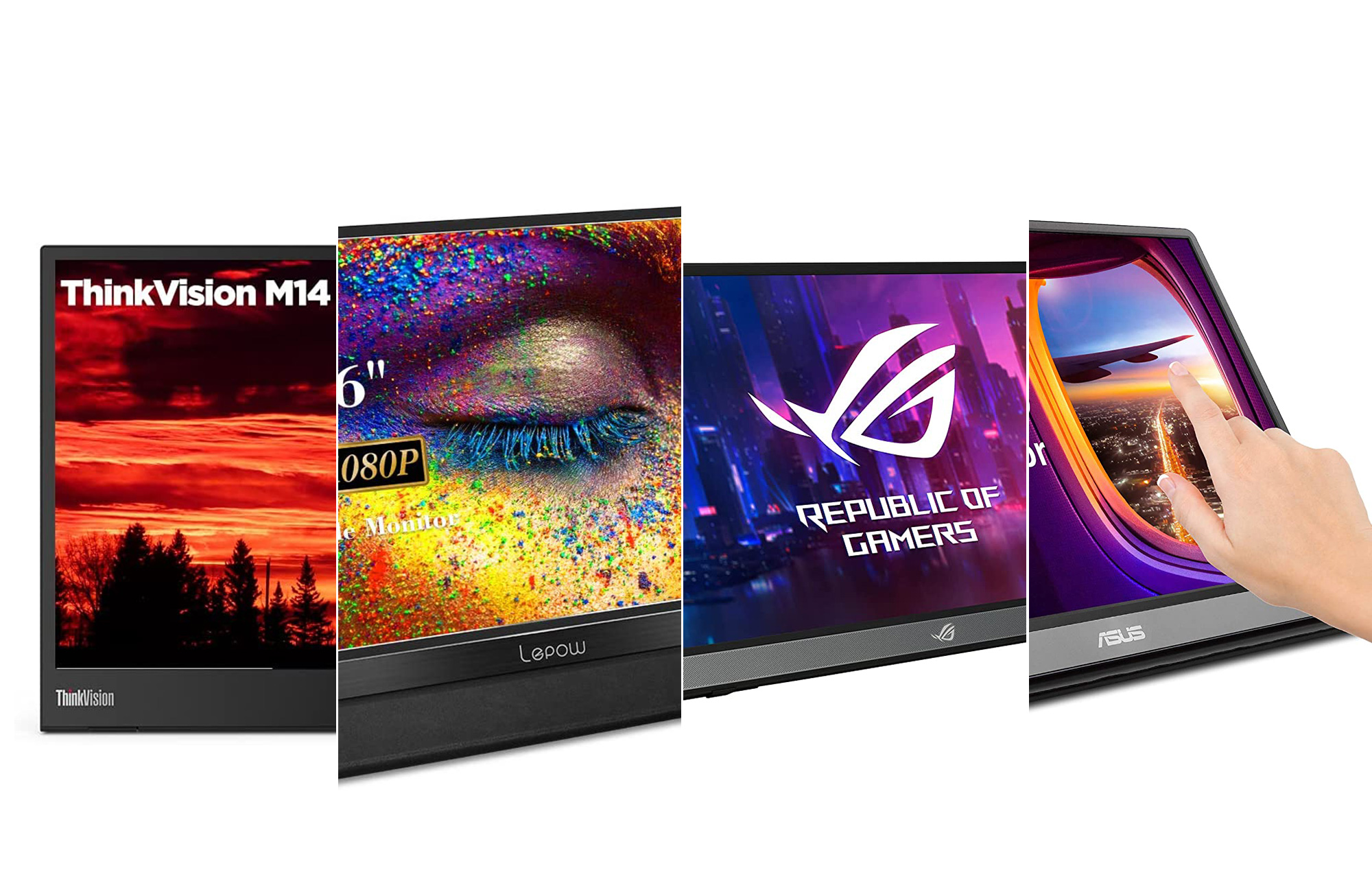
When you’re using a laptop or traveling and need more screen real estate, portable monitors provide new versatility and solid picture quality in an easily portable form factor. Plus, laptops, tablets, and smartphones provide convenience and mobility, but those small screens can cause headaches, blurry eyes, and fatigue. Trying to crowd a lot of information on such a small screen only exacerbates the problem—especially if you’re using computer devices for several hours a day. However, a portable monitor can provide a much better working and viewing experience. Picking the right one for you will depend on several factors, but we’ve done the legwork to select and highlight the best portable monitors currently on the market.
- Best overall: ASUS ROG Strix (XG16AHPE)
- Best for laptops: Arzopa Portable Monitor 2K
- Best 4K: Innocn 15.6-inch OLED Portable Monitor (PU15 PRE)
- Best portable touchscreen: ASUS ZenScreen Touch MB16AMT
- Best for vertical use: Arzopa A1C
- Best for drawing: Espresso Display
- Best for gaming: Nexigo 17.3” 300Hz
- Best multi-screen: LIMINK LK14
- Best unattached multiscreen: The Portable Monitor Slide
- Best budget: Arzopa A1 Gamut
How we chose the best portable monitors
As a freelance journalist for over 10 years, I’ve reviewed home and tech products for publications including PopSci, CNN Underscored, NBC News Select, Popular Mechanics, Architectural Digest, Tom’s Guide, The Daily Beast, USA Today’s Reviewed, Apartment Therapy, The Spruce, and Bob Vila. Our personal monitor selections are based on personal testing, extensive research, recommendations from fellow critics, and user impressions.
The best portable monitors: Reviews & Recommendations
A portable monitor can give you a dual-monitor experience even when you’re away from your desk setup. Even with the limitations of their size and form factor, the best portable monitors come in different sizes and have different features that can help you be more efficient with less digital eye strain. Whether you need it for work, school, or play, at least one of these displays should be a perfect fit.
Best overall: ASUS ROG Strix (XG16AHPE)
Best portable monitor
Best of The Best
Buy it used or refurbished here: eBay
Why it made the cut: The ASUS ROG Strix has a high refresh rate and lots of great features, making it the best choice for most people.
Specs
- Screen size: 15.6 inches
- Weight: 1.98 lbs
- Resolution: 1920 x 1080
- Display type: LED
- Refresh rate: 144Hz
- Inputs: HDMI, USB, Audio jack
- Battery life: 7,800 mAh
Pros
- 144Hz refresh rate
- Landscape and portrait modes, plus a universal tripod
- Nvidia G-Sync compatible
- Battery-powered option
Cons
- Expensive
Perhaps unsurprisingly from a company that makes excellent, and at times affordable, battlestation accessories, the best portable monitor is made for gaming. The ASUS ROG Strix 15.6-inch portable monitor is one of only a handful of models with a 144Hz refresh rate, which provides smooth animation in and out of games.
Even if you don’t play much, it has some incredibly useful bells and whistles. Its kickstand rotates, so you can easily switch between traditional landscape or vertically-minded portrait mode. It also has stereo speakers in case you forget your headset at home.
In addition to a micro-HDMI to HDMI cable, a USB Type-C cable and a USB Type-C to A adapter are also included. One usual feature is the universal tripod socket—a hole with a ¼” thread—which makes it convenient to use the portable monitor with a tripod stand. However, a sleeve, which can be used as a stand, is also included.
If you really want to max out your portable gaming setup, ASUS also makes an even bigger 17.3-inch version of the Strix portable monitor with a 240Hz refresh rate. Most people, even gamers, don’t really need a 240Hz display, which is why we recommend the less expensive model. It may be worth the extra cash if you want to carry around a zero-compromises esports display, however.
Best for laptops: Arzopa Portable Monitor 2K
Best portable monitor for Laptops
Small But Mighty
Buy it used or refurbished here: eBay
Why it made the cut: Arzopa’s monitor has a higher resolution than we expected to see at its price.
Specs
- Screen Size: 13.3 inches
- Weight: 1.41 pounds
- Resolution: 2560 x 1600
- Refresh rate: 60Hz
- Inputs: 2 USB-C, 1 Mini HDMI, 1 headphone jack
- Battery life: N/A
Pros
- Compact size
- High-resolution screen
- Three inputs
Cons
- USB-C ports on one side
If you want something to pair with a smaller laptop, the 13.3-inch is the ideal second screen. The portable monitor has the same resolution as Apple’s 13-inch MacBook Pro (pictured above), which makes them a particularly good pair. Text, images, and videos look sharp on Arzopa’s screen, although I recommend immediately enabling its HDR mode, which wasn’t on by default. This setting will make colors look a lot more accurate, which is necessary if you’d like to use the portable monitor for image or video editing. In our tests, this portable monitor with a MacBook Pro benefited our productivity.
We were used to working on a display of its size and resolution, which made adapting our workflows a lot easier. Arzopa’s monitor has two USB-C ports and one Mini HDMI port to connect multiple devices simultaneously. The company bundles the portable monitor with both a USB-C cable and mini-HDMI cord so that you can use it with all of your devices right out of the box. Our only complaint is that both USB-C ports are located on one side, requiring us to snake the cord around the back of our MacBook to its Thunderbolt 4 ports. It’d be perfect if Arzopa could update this portable monitor’s design with one USB-C port on both sides.
Overall, we were happy with how easy the monitor was to set up and use. Our MacBook Pro recognized the monitor immediately, and we could adjust its resolution and color profile settings in the Display Preferences section of MacOS. It was also easy to adjust the monitor’s brightness, contrast, and HDR settings through a little switch on the right-hand side of the display. It only took about five minutes to fully set up Arzopa’s monitor, and it would’ve taken less time if we weren’t messing around with different settings.
Most 13.3-inch portable monitors are only 1080P, and the extra resolution on Arzopa’s 2K display makes a big difference. The ability to see even more information on the screen is reason enough to upgrade if you have a lower-resolution second screen. This is an excellent place to start if you’re new to portable monitors.
Best 4K: Innocn 15.6-inch OLED Portable Monitor (PU15 PRE)
Best 4K Portable Monitor
Crystal Clear
Why it made the cut: The Innocn PU15 PRE is expensive, but its 4K OLED display is incomparable among portable displays.
Specs
- Screen size: 15.6 inches
- Weight: 2.07 lbs
- Resolution: 3840 x 2160
- Refresh rate: 60Hz
- Inputs: USB and HDMI
- Battery life: 5,000 mAh
Pros
- 4K resolution
- OLED panel
- Touch screen
- Portrait and landscape modes
Cons
- Very expensive
Innocn’s top OLED portable monitor is the most expensive pick on our list, and for good reason. Among desktop monitors and laptops, 4K OLED touchscreens don’t come cheap (and we won’t even talk about the best OLED TVs prices). Among portable monitors, they are virtually unheard of. Organic Light-Emitting Diode (OLED) displays feature self-emitting backlit pixels that can independently turn on and off when an image calls for it, producing incredible contrast and a more vivid picture. Combine that with 4K resolution, and, well, it’s very pretty.
Meanwhile, the touchscreen feature allows you to use the portable monitor like a drawing tablet. It has stereo speakers, in case you need them, and it can be used in both portrait and landscape mode. At $799.99, it is considerably more expensive than the rest of our picks, but it also delivers a higher class of picture.
Best portable touchscreen: ASUS ZenScreen Touch MB16AMT
Best portable touchscreen monitor
You’ve Got The Touch
Buy it used or refurbished here: Amazon
Why it made the cut: The ASUS Zenscreen Touch’s portable touchscreen is responsive and easy to use. You can even draw on it.
Specs
- Screen size: 15.6 inches
- Weight: 1.98 pounds
- Resolution: 1920 x 1080
- Display type: LCD
- Refresh rate: 60Hz
- Inputs: 2 Micro USB
- Battery life: 7,800 mAh
Pros
- Touchscreen
- Built-in speakers
- Compatible with Thunderbolt 3
Cons
- Have to download driver for USB Type-A connection
The ASUS ZenScreen Touch’s 10-point 1080p touchscreen won us over with its intuitive fingertip control, which makes it incredibly easy to make changes to documents, play games, and draw on slides. It comes with many of the basic features we look for, including stereo speakers and a smart case kickstand. Having a portable monitor with a touchscreen is especially helpful for traveling workers getting things done on a phone. You can use the ZenScreen Touch app to control your Android phone, making it a perfect pairing for a powerful smartphone like the Samsung Galaxy S23 Ultra. There’s even a smartpen holder for your stylus to ensure you don’t lose it when not in use.
Best for vertical use: Arzopa A1C
Best budget gaming monitor
The best budget portable monitor
Why it made the cut: Arzopa’s A1C is a 15.6-inch portable monitor that can be used for email and Slack.
Specs
- Screen size: 15.6 inches
- Weight: 1.69 lbs
- Resolution: 1920 x 1080
- Display type: LED
- Refresh rate: 120Hz
- Inputs: HDMI, USB, Audio jack
- Battery life: N/A
Pros
- Price
- Multiple connectivity options
- Low blue light protection
Cons
- Hinge system is finicky
Arzopa’s A1C portable monitor shares many of the same features as the company’s 2K model, which we recommended earlier, but at a significantly lower cost. The build quality of the display is solid, save for its folding stand, which required a fair amount of time to fully understand.
You need to fold it in a particular way, which was unclear due to the vague instructions—that said, setting up the monitor was smooth sailing once we got the hang of it. You can connect this portable monitor to your device using the included USB-C to USB-C or micro-HDMI to HDMI cable. We exclusively used the former. Our computer quickly recognized the monitor, and we could immediately begin using it.
This display’s 1080P resolution is a step down from Arzopa’s 2K model, but it still displayed colors very well, and text looked pretty clear. HD videos looked perfectly fine on this monitor, and the display is the perfect place to keep spare windows you need to use or reference while working on your computer’s main screen. While the A1C can be used horizontally, using it vertically will make it more comfortable to view certain applications. Email and chat apps (think Slack or Google Teams) work particularly well this way, as do long-form articles.
Basically, turning the monitor on its side gives you a more smartphone or tablet-like experience. The only downside is you have to deal with a cable sticking up over the monitor to your computer. When the A1C is used in this capacity, it can improve your productivity. If you’re trying to mitigate the negative effects of staring at a screen all day, you’ll appreciate this monitor’s built-in blue light protection, which may reduce eye strain during extended use.
If you’ve been holding out on getting a portable monitor by waiting for a good deal, it’s hard to argue with the Arzopa A1C’s value.
Best for drawing: Espresso Display
Best for drawing
Espresso Display
Why it made the cut: The Espresso Display has a stylus pen that can be used to draw, sketch, retouch photos, and edit videos on the portable monitor.
Specs
- Screen size: 15.6 inches
- Weight: 2 pounds
- Resolution: 1920 x 1080
- Display type: LCD
- Refresh rate: 60Hz
- Inputs: USB-C (2)
- Battery life: N/A
Pros
- Touchscreen with stylus function
- Automatically rotates
- Ultra-thin design
- Available in 2 display sizes
- Compatible with various artistic apps
- Built-in speakers
Cons
- Stylus (plus stand and case) are extra
Creatives looking for a portable monitor to complement their main display will appreciate the level of functionality and convenience available on the Espresso Display. It has both touchscreen and pen capabilities, which makes it easier to be productive anywhere. The portable monitor, made of aeronautical grade aluminum, offers two USB ports and is compatible with Mac. It can also support numerous apps, including Photoshop, Illustrator, Sketchbook, Microsoft Whiteboard, Mural, FigJam, Miro, and ZBrush.
The monitor can be used for document markups as well as whiteboarding. The 15.6-inch version is the largest of the espresso Display models (the other two are 13-inch and 13-inch touch versions), but it’s incredibly slim: 0.2 inches thin and weighing only 2 pounds.
The only problem we found with the espresso Display is that everything is considered extra. The company ships the espresso Display Monitor, USB-C to USB-C cable, and a cleaning cloth. However, the pen, stand, and case are extra. These items can be purchased separately or in a bundle.
Best for gaming: Nexigo 17.3” 300Hz
Best for gaming
Nexigo 17.3” 300Hz
Why it made the cut: The generous screen provides plenty of viewing space, and the 300Hz refresh rate is ideal for gaming.
Specs
- Screen size: 17.3 inches
- Weight: 2.5 pounds
- Resolution: 1920 x 1080
- Display type: IPS
- Refresh rate: 300Hz
- Inputs: USB-C, HDMI, 3.5mm headphone jack
- Battery life: N/A
Pros
- 300Hz refresh rate
- Adjustable kickstand
- Dual Hi-Fi Speakers
- FreeSync, G-SYNC
- Delta-E <2 color accuracy
- Built-in kickstand
Cons
- Doesn’t come in a 13-inch version
If you need an extra monitor for gaming but would prefer something portable that’s easy to break down, store, and transport, the Nexigo 17.3” 300Hz portable monitor certainly fits the bill. The generous 17.3-inch screen eliminates the need to squint and ensures that you can see more of the game. It’s compatible with Playstation, Switch, and Xbox. Or you can use it with any game console with an HDMI or USB Type-C output.
The monitor features a 300Hz refresh rate and is compatible with FreeSync and G-SYNC to provide a seamless gaming experience and lag-free response time. Gamers will find this particularly important as tearing and stuttering are greatly minimized. And the Delta-E <2 provides accurate colors for a more realistic experience.
The dual Hi-Fi speakers make it easier to hear and be immersed while gaming, though you’ll likely still want to invest in a gaming headset. The built-in kickstand keeps the portable monitor securely in place and can be adjustable from 50 degrees to 80 degrees. There’s also a magnetic protective cover to keep the monitor safe from dust, a foldable stand, and an IR remote.
In addition to the 17.3-inch model, Nexigo also makes a 16-inch version along with models with different refresh rates.
Best multi-screen: LIMINK LK14
Best multi-screen
LIMINK LK14
Why it made the cut: Dual monitors attach to either side of your laptop to provide a 3-screen setup.
Specs
- Screen size: 14 inches on each side
- Weight: 3.3 pounds
- Resolution: 1920 x 1200
- Display type: IPS
- Refresh rate: 60Hz
- Inputs: USB-C, HDMI, Displayport, VGA
- Battery life: N/A
Pros
- Leather Smart Case
- Kickstand on back and top center
- Delta-E <2 color accuracy
- Fits 13-inch to 16-inch laptops
Cons
- Not compatible with M1 and M2 chip MacBooks (but does support M1 Pro and M1 Max chip).
Perhaps the only thing better than an extra monitor is two extra monitors. The LIMINK LK14 Portable Triple Monitor attaches to your laptop and provides one monitor on the left side and another one on the right side. (Note: dual monitor setups are referred to as “triple” monitors because when set up correctly, they provide three monitors – including the laptop’s monitor).
We like this dual monitor setup because it doesn’t put undue pressure on the laptop. The LIMINK LK14 uses metal clips and a pull ring to attach the device. The 8-level kickstand on the back ensures that the installation is secure and allows the laptop screen to be tilted from 0 to 45 degrees. Since there are two monitors, it requires two cables to connect (one for each monitor). It’s worth noting that each monitor has three ports.
The aluminum alloy body is strong and corrosion-resistant, but the monitors are still lightweight. When the monitors are not in use, they collapse in the middle and can be stored in the leather smart case for easy transportation.
Best unattached multi-screen: The Portable Monitor Slide
Best unattached multi-screen
The Portable Monitor Slide
Why it made the cut: You don’t have to attach your laptop to these dual portable monitors physically, and it can fold into a triangle for sharing your screen with others.
Specs
- Screen size: 13.3 inches x 2
- Weight: 4.4 pounds
- Resolution: 1920 x 1080
- Display type: IPS
- Refresh rate: 60Hz
- Inputs: USB
- Battery life: N/A
Pros
- Both monitors are rotatable
- 14-level kickstand
- Connects via single cable
- Available in 2 finishes
Cons
- Costs a pretty penny
- Heavier than some dual monitors
Like most snobbish MacBook owners, I like to keep my laptops smooth and clean—so I don’t really like the idea of attaching anything to the exterior. Fortunately, the Slide not only fits on laptops of any size, but the dual monitors are also standalone, so I can just slide my laptop monitor right up against the area where the laptop attaches. This means that I can also use the dual monitors with a smartphone or tablet instead of a laptop.
Most dual portable monitors need two cables (one for each monitor). However, the Slide only needs one cable for power and video transfer from both monitors. This results in a cleaner, less-cluttered workspace.
The dual monitors can rotate to form a triangle (the left monitor rotates 180 degrees, and the left monitor rotates 60 degrees), making this an excellent choice for presentations or group collaborations. This configuration allows you to provide three viewing angles instead of having people crowd around you. Even when you’re not presenting, having two extra screens significantly increases your viewing real estate. The Slide is available in either a Premium Aluminum or a Carbon finish.
Best budget: Arzopa A1 Gamut
Best budget
Arzopa A1 Gamut
Why it made the cut: The Arzopa A1 Gamut offers an ideal balance of features, quality, and price.
Specs
- Screen size: 15.6 inches
- Weight: 1.44 lbs
- Resolution: 1920 x 1080
- Display type: LCD
- Refresh rate: 60Hz
- Inputs: Mini HDMI, dual USB-C, Audio jack
- Battery life: N/A
Pros
- Compatible with most devices
- IPS display offers large viewing angles
- Bright, large display
- Plug-and-play design
Cons
- New stand design is a separate piece that could get lost
- Built-in speakers are lacking in quality
Too often, you have to choose between quality and price. The Arzopa A1 Gamut offers a compromise with excellent quality despite the reasonable $149 price. And it frequently goes on sale, so you can usually get it much cheaper. The large 15.6-inch display with slim bezels provides a large viewing area. It made our transition from a large desktop monitor to a portable monitor much easier when on the go.
Arzopa designed the A1 Gamut with an FHD (1920 x 1080) resolution, which results in sharp, clear images and text. You can easily adjust the brightness on the side of the monitor. We found it plenty bright, even when working in rooms with lots of windows and light. And the IPS display makes it easier to see at a range of angles, even if there are windows directly behind you. The 1200:1 contrast ratio is higher than many portable monitors, resulting in a rich, attractive display. While it won’t provide perfectly accurate colors, it works for editing photos in a pinch—just be prepared to make adjustments if you plan on printing the images later.
The A1 Gamut is incredibly easy to set up and use. It comes with all of the cords you may need to connect to your favorite devices and features two USB-C ports along with a mini HDMI port. All you need to do is plug in the monitor, which automatically turns on. You won’t need to fuss with downloading drivers or anything of the sort, as it’s a true plug-and-play device. The main downside is that the ports are all on the left side, which happens to be the same side as our MacBook Pro, making the connection a little less than ideal.
Arzopa redesigned the stand since our version, and it is now a separate metal piece. That separate piece could be easy to lose. But it offers an adjustable height, which is not typical for portable monitors, and makes the display more ergonomic. Unfortunately, the new stand means there is no longer a built-in cover for the A1 Gamut, so you will want to take care when packing it up for travel.
What to consider when buying the best portable monitors
There are several factors to consider when choosing between portable monitors. Budget, resolution, and ease of connectivity are usually top of mind. However, other factors may depend on your personal preferences. These are some of the features you should keep in mind to ensure the portable monitor meets your needs:
Screen size
Portable monitors tend to mirror the sizes of laptop displays, coming in sizes from 14 inches to 15.6 inches to 17 inches. Since you’re always moving portable displays around, picking a screen size comes down to personal preference. A larger screen looks great and makes things easier to see, but remember that a larger screen will take up more space on your desk or table and in your laptop bag or suitcase.
Connectivity
Most portable monitors connect to devices via USB-C and/or mini-HDMI cables (such as this inexpensive AmazonBasics option). While an increasingly wide array of phones, tablets, PCs, and other devices support USB-C, you may need a USB-C hub, adapters, or a USB-A to USB-C cable. Likewise, if you already have a standard HDMI cable, you may need to purchase an HDMI to mini-HDMI adapter for mini-HDMI-based screens. Make sure that the monitor you select has the ports you need to pair it wherever you plan to use it, including your laptop, smartphone, tablet, camera, and game consoles.
Resolution
Your portable monitor’s resolution will determine the sharpness and clarity of its picture. As you can see, based on our selections, most portable monitors support 1080p resolution (often referred to as Full HD). That puts it on par with most basic and mid-range desktop monitors. There are high-resolution models, including some portable 4K monitors. And, just like when shopping, say, for desktop monitors for Macs, they cost quite a bit more.
Refresh rate
Refresh rate, measured in hertz (Hz), refers to how many times your monitor can redraw an image each second. A higher refresh rate opens the door for a higher frame rate in games and smoother movement in menus and other software. All monitors on this list feature a 60Hz refresh rate, meaning the screen updates 60 times a second. That’s lower than we’d recommend for a standard monitor, but it is standard among portable monitors. That said, there is a 144Hz display, which stands out as an especially good choice for gaming and drawing.
All IPS, all the time
While desktop monitor panels come in a few flavors, all of the portable monitors on our list are In-Plane Switching (IPS) displays. This technology ensures color accuracy and better views from wider angles (for example, even if someone is standing on the far-left side of the monitor, the view should be good. However, it’s debatable if an IPS display panel makes that much of a difference in a portable monitor.
Audio
Some portable monitors include built-in speakers (and headphone jacks), which may or may not be important in certain situations. If you’re connecting your monitor to a computer or phone, you may already have the audio covered through the device. In general, the speakers on these monitors aren’t especially impressive, so powered desktop speakers or over-ear headphones are usually the way to go. That said, if you think that monitor audio will be useful, be sure to check for that feature.
FAQs
Using a portable external monitor makes a lot of sense when you are traveling and need to temporarily set up a multi-display workstation. The ability to see clearer and avoid jumbled text and data can help you avoid making mistakes and also decrease digital eye strain. They’re also very convenient for presentations and group projects, where you need to share your screen with others.
Some portable monitors feature stereo speakers. Frankly, though, even the best of them deliver mediocre sound. You’re likely better off pairing a nice pair of Bluetooth headphones or a portable Bluetooth speaker with your primary device.
We think the ASUS ROG Strix is the best portable monitor. It has a 144 Hz refresh rate, rotatable screen, and dual speakers, in addition to a variety of cables and a universal tripod socket.
This depends on its size, resolution, and set of features. You can spend as little as $150 or as much as $779.99 on a portable monitor.
Final thoughts on the best portable monitors
- Best overall: ASUS ROG Strix (XG16AHPE)
- Best for laptops: Arzopa Portable Monitor 2K
- Best 4K: Innocn 15.6-inch OLED Portable Monitor (PU15 PRE)
- Best portable touchscreen: ASUS ZenScreen Touch MB16AMT
- Best for vertical use: Arzopa A1C
- Best for drawing: Espresso Display
- Best for gaming: Nexigo 17.3” 300Hz
- Best multi-screen: LIMINK LK14
- Best unattached multiscreen: The Portable Monitor Slide
- Best budget: Arzopa A1 Gamut
A portable monitor helps make it easier to do serious work away from your primary work setup. Having more screen space to spread out all your windows can help you keep track of things. Looking at a larger display, especially compared to a phone’s screen, will help reduce eye strain. Plus, you have a way to mirror your screen and show other people. If money is no object, the Innocn OLED provides the best resolution possible. However, you can spend a lot less and get something very useful, from the gaming-focused ASUS ROG Strix to the very affordable Arzopa A1 Gamut. No matter what you go with, simply having one of these displays should hopefully make your life a little easier.
